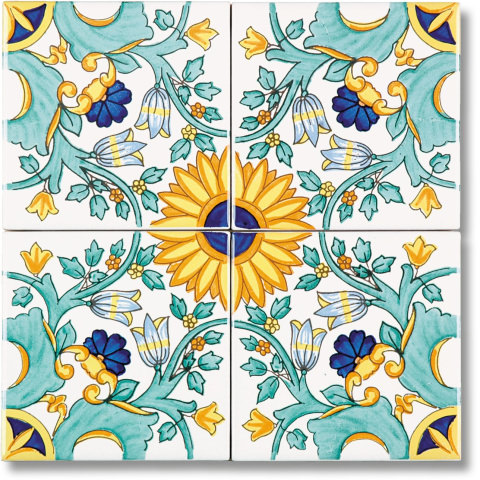Vietri and the ceramic
Land of talents, art, creativity and colors
Vietri sul Mare, the "first pearl" of the Amalfi Coast, is one of the most important coastal municipalities in the province of Salerno, located in the most protected corner of the homonymous gulf. Already inhabited at the time of the ancient city of Marcina (presumably founded by the Tyrrhenians), the town, in addition to offering a splendid sea, is surrounded by magnificent Mediterranean vegetation.
Like all the towns of the Amalfi Coast, one of the most beautiful corners of paradise in the world certified by UNESCO with the seal of World Heritage, Vietri sul Mare has a strong tourist vocation and is famous for the production of ceramics.
For those arriving from the sea, the majolica show of the dome of the church of S. Giovanni Battista, the main seventeenth-century city monument, is the first impact with this ancient art that completely pervades the life, trade and artisan activity of Vietri .
The history of the ceramic industry, with a thousand-year tradition, can be traced with a visit to the Manuel Cargaleiro Industrial Artistic Museum of Ceramics and to the Provincial Museum of Ceramics which is based in Villa Guariglia.
All the colors of the Amalfi Coast seem to meet in Vietri, in the glazes and decorations of the ceramics produced since 1600. Creative synthesis, immediacy of image, colors that come together by contrast and not by nuanced overlapping, these are the characters that mark the path of ceramic production in the city then as today a very important crossroads of marine trade in the Mediterranean.
News of a flourishing activity linked to the production of ceramics date back to the fourteenth century as evidenced by the great demand for tiles and tiles produced in the nearby farmhouse of Vietri sul Mare, by the master builders of that period. But there is certain documentation of the terracotta industry in Vietri in the 16th century with the production of kitchen utensils and household items such as dishes, lancets for storing water, bowls and small jars for storing spices and drugs.
It was, however, in the seventeenth century that the qualitative leap took place, when the Vietrese Ceramics was enriched with more accomplished forms and artistic decorations that led to the creation of objects related to religious worship such as domestic fonts, majolica tiles with a religious subject, panels and the votive niches still scattered in the alleys of the area.
It was, however, in the seventeenth century that the qualitative leap took place, when the Vietrese Ceramics was enriched with more accomplished forms and artistic decorations that led to the creation of objects related to religious worship such as domestic fonts, majolica tiles with a religious subject, panels and the votive niches still scattered in the alleys of the area.
The growing commercial ties combined with the unique characteristics of the territory and the particular originality of the Vietri craftsmen attracted, from the 1920s onwards, the arrival on the coast of world-renowned artists and craftsmen (Irene Kowaliska, Riccardo Dolker, Giovannino Carrano) which led Vietri to become one of the recognized capitals of the production of art ceramics. Vietri's ceramic workshops are a show within a show. The narrow streets of the village are dotted with small shops and craft shops where the art of ceramics reaches truly unique levels, both in terms of shapes and colors. Each object and furnishings is re-proposed in ceramic: tiles, plates, object holders, ashtrays, amphorae and ornaments of all kinds, vases, statuettes, tea and coffee sets, sacred objects and the very famous donkeys.
The donkeys, which later became the symbol of Vietri ceramics, are an 'invention' of German ceramists who, attracted by the sun and the sea, between the 1920s and 1940s, moved to the charming coastal town. Skilled chemists, the Germans invented formulas with which they created particular colors of the ceramics, considered "unique", among them the famous "Vietri yellow".
Styles and contaminations are still being proposed. In the same way, however, we aspire to new experiences: from the classic warm tones of these places, we move on to glimpses of the country and scenes of everyday life and imaginary and contemporary figures. These are the details that determine the strong personality of the inimitable Vietri Artistic Ceramics.
© 2024 Di Palma Claudia
2015 website by dynform.it
& studio150.it
& studio150.it














